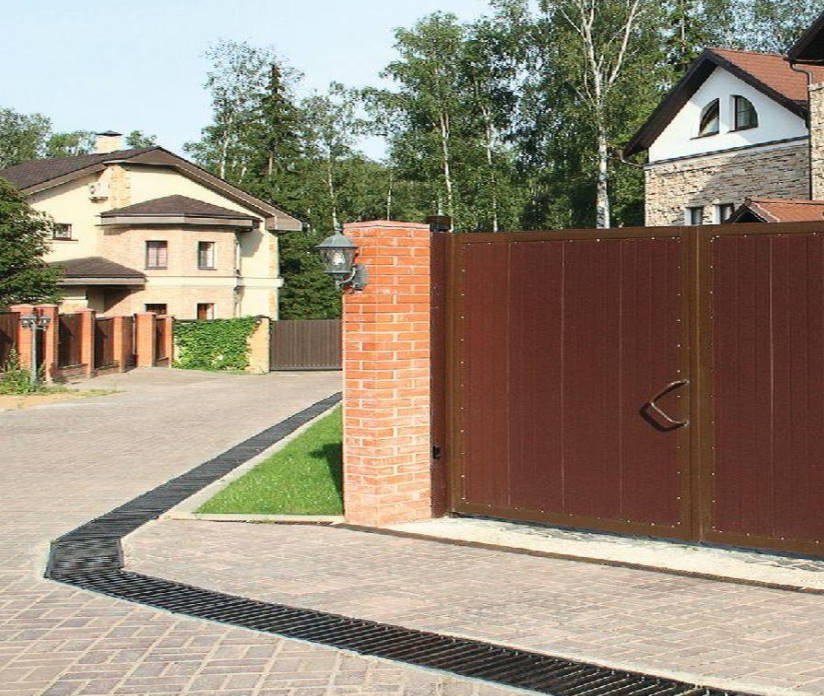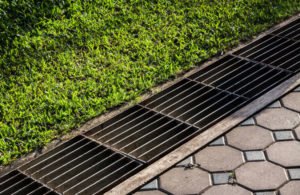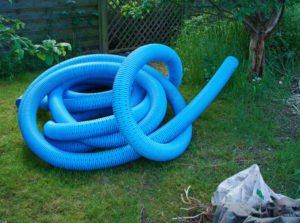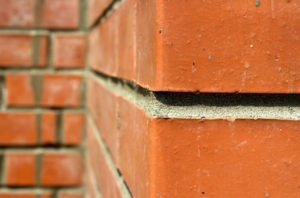Groundwater-the worst enemy of the foundations of country houses. They also harm garden trees, paths, lawns. However, there is a fairly simple and not too expensive way to reduce the amount of moisture in the area — a device surface drainage.
Selection and installation of surface drainage system
The surface drainage system is essentially a network of shallow channels and buried in a small (30-50 cm) depth of pipes that drain water from the surface of the soil into the storm sewer, and in its absence — into the roadway, the river, on a low relief or in a special well. Such a network helps to get rid of lawns after melting snow and heavy rains, prevents washing of the fertile layer, damage to the bridge and the Foundation of the streams of water pouring from the roof of the house. If it is available on the site in the fall can reduce the level of groundwater, and thus reduce the frost heaving soil.
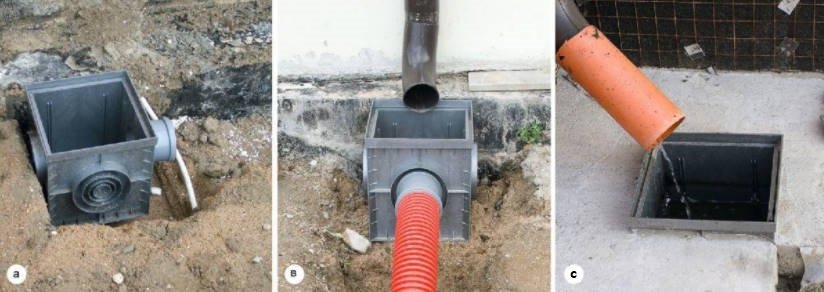
In the photo:
- Storm-water inlets installed before the construction of the blind area (a).
- They are connected to the drainage network using plastic pipes (b).
- If the system bandwidth calculation is done correctly, the capacities will not overflow (c) in the rain.
Points and lines
Distinguish between point and linear drainage:
- The first is a buried storage tanks (rain collectors), water from which is discharged through underground pipes. Storm-water inlets often feature under the gutters of the roof, and the playing of the pipes of the water supply system, at least — in places where, because of topography, possible local accumulation of water.
- Linear systems consist of channels laid flush with the surface of the soil, and are designed to collect water from the yards, roads and paths, which give a slight slope towards the water receivers.
Earlier for linear drainage in the suburban area dug grooves with a depth of 20-30 cm, filled them with coarse gravel or put them in asbestos cement gutters. Asbestos cement and ceramic pipes were used for local water drainage. But the gravel system did not last long: after two or three seasons, especially on problem soils, it was clogged with particles of silt and clay. And asbestos channels and pipes it was very difficult hermetically to dock.

Elements of drainage systems: drainage trays (a), communication tray with drainage pipe (b), rain receiver (c)
Today the market offers a wide choice of drainage trays with lattice covers, pallets, rain collectors, sand traps (the latter protect the system from clogging) and other components. The system of ready-made modules with sealed joints is easy to install and operate and does not spoil the view of the site, and sometimes even serves as a kind of decoration.
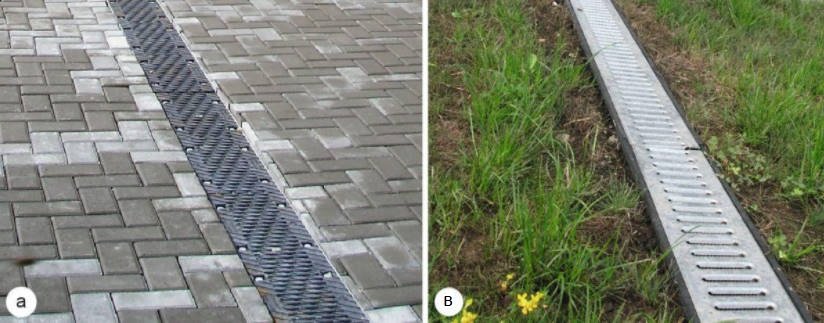
Drainage channels are laid in areas with road surface (a), but when they are used to drain water instead of pipes, trays simply dug into the ground (b)
Choose the material
Nowadays, the main elements of the drainage system — drainage trays and rain collectors-are made of concrete (by vibropressing), polymer concrete, polymer composites (polymer resins with different fillers) and plastic (mainly polypropylene). These materials, in addition to plastic, are quite expensive, besides the installation of concrete trays require lifting equipment. Therefore, most often in the suburban area use plastic parts: durable, frost-resistant and designed for at least 10 years of operation. They have a groove-and-groove connection, which does not require additional sealing during installation.
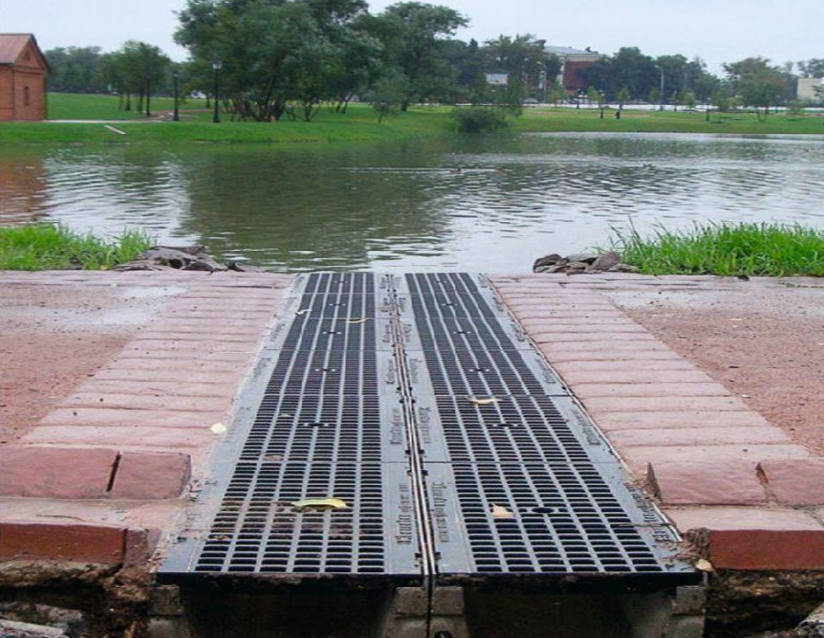
Usually water from drainage channels is discharged through pipes, but sometimes it is possible to pour directly on the ground, fortified with a layer of large gravel, or in an open pond
Trays closed grates-plastic, galvanized or stainless steel or cast iron. The service life of stainless steel grates — more than 20 years, cast iron — 50 years, but galvanized products only 7-10 years.
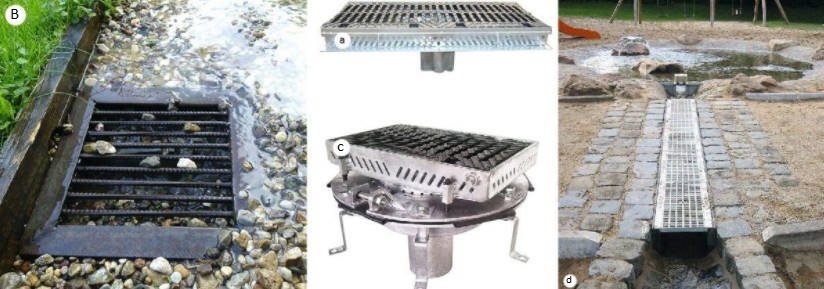
For point catchment is sometimes used pallets with perforated walls (a, b, c). They can be used to be drained, for example, paths of gravel. Stainless steel wire meshes (d) are designed for heavy loads
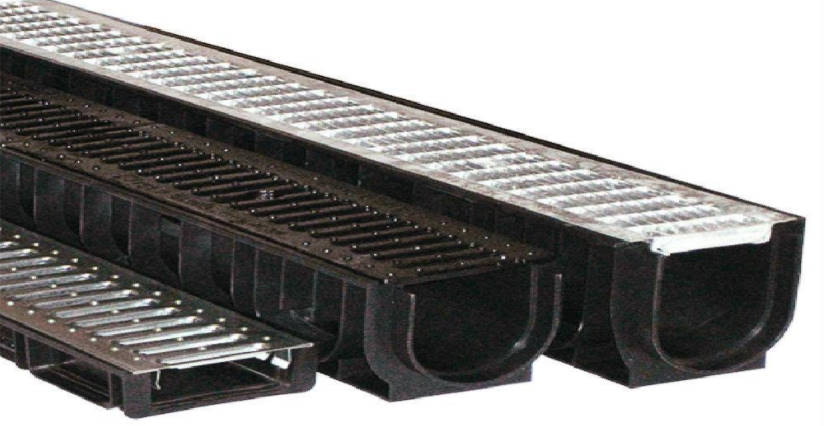
Ribs on the walls and the bottom of the trays are necessary for strong adhesion to the Foundation
Exact calculation
When selecting the elements of the drainage system it is important to take into account the external mechanical load on it. Many manufacturers use the European norm that divides products into six classes depending on the maximum permissible load. In private construction products are mainly used in the first three classes-A15, B125 and C250 (the numbers after the letters indicate the test load in Newton). Products designed for class A15 pedestrian areas, and В125 class C250 — on the road entrances. Note that plastic trays can be assigned class C250 and even higher, that is, they are able to withstand the weight of the truck. But plastic grilles can be installed only in pedestrian areas. Steel lid suitable for yard and garden areas, walkways, and metal thickness over 1.2 mm — for the access of the alley. Cast iron pipes and fittings designed for the passage of a loaded truck.
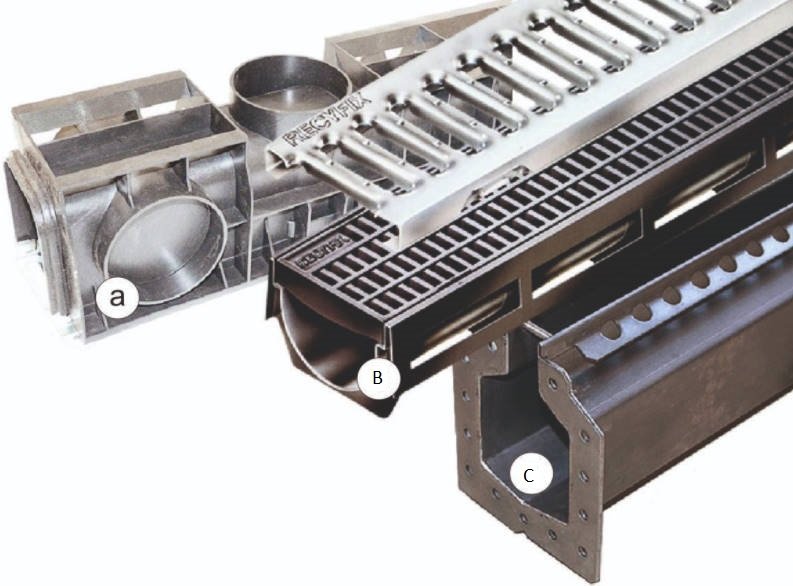
Drip pan with two connection options of the pipe (a), the tray with grid (b) and slit tray (c)
At selection of section of trays, pipes and accumulators it is desirable to carry out hydraulic calculation. It can be performed for you free of charge by specialists of companies offering components for drainage systems. To design a network of channels and pipes better with a good supply of their capacity.
Competent installation
The drainage system should be installed in conjunction with the construction of drained areas. Otherwise, it will cost more because of the partial destruction of road surfaces, damage to flower beds and lawns. It will be impossible to organize the slump of the sites, and therefore, the length of the channels will have to increase. Installation works begin with a marking. Channels need to give a slope of approximately 1% in the direction of the spout; the lid should be flush with the draining surface, so the strips indicate with the help of pegs and stretched between them the cord. Then proceed to the construction of the Foundation for trays and containers. The Foundation is performed in the form of reinforced concrete tape 20-30 cm wide and 22-35 cm high, and it is better to do it with a broadened sole to avoid vertical movements. Trays pressed into the liquid concrete, connecting so that the sheet piles looked towards the spout. Begin with the tray, which is located closer to the lower mark of the route. Pipe point of the catchment are laid in trenches for leveling sand cushion. In places the tray turning and docking trays and inlets with underground pipes install a sand trap.
The scheme of installation of drain tray
1-road tile;
2-sand cushion;
3-tray;
4-gravel filling;
5 — the Foundation;
6 — the soil.
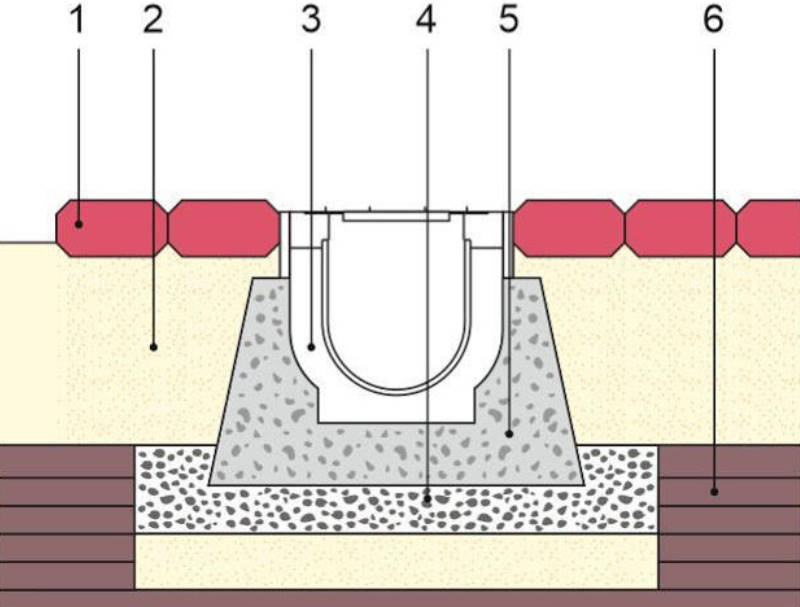
The scheme of installation of drain tray
Just to be clear
Dirt and sand, debris and fallen leaves inevitably fall into the surface drainage system. To avoid serious blockages, it is necessary to wash sand traps at least 2 times a year — after the spring flood and in September — October. Every 2-3 years it makes sense to carry out General cleaning of the entire system. In this case, dismantle the grille, remove the dirt from the trays, underground pipes are washed with a powerful jet of water, clean the Central shaft. If the pipe is still a traffic jam of mud and leaves, then to remove it, use a metal cable.

To avoid serious blockages, it is necessary to wash sand traps at least 2 times a year
Typical errors with drainage device
- The trays are installed without concrete pads. In winter, they are likely to squeeze out of the ground forces of frost heaving.
- Trays are laid without slope or with a contruction. Water will freeze when cold, which can lead to cracks in the walls of the channels.
- The side of the tray rises above the drained surface. Water will not flow into the tray and finding workarounds, forming puddles and eroding soil.
- There is a sand trap. Underground pipes quickly clogged, and cleaning is a labor — intensive and troublesome.
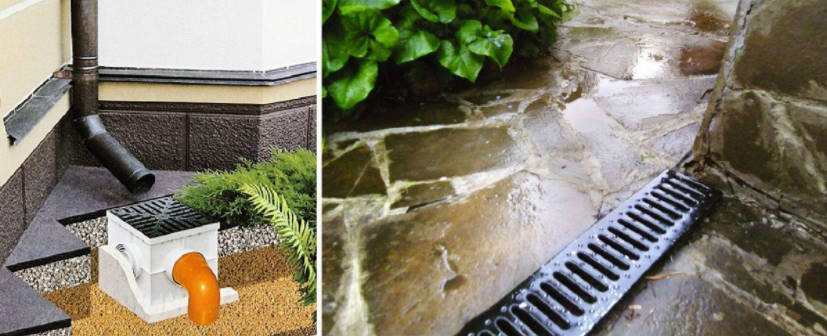
The drainage system from the roof must be supplemented with a point drainage system. Otherwise it is almost useless. The channel located above the adjacent surfaces, almost does not collect water. The reason is that the grid is not set up to, and after, was a material paving — stone.
Deep drainage
In lowlands, wetlands surface drainage must be combined with deep. The construction of the latter will not cost much, but in many cases it is the only means to make the land suitable for construction and gardening. Deep drainage is a system of perforated pipes (drains) with a diameter of 100-200 mm, laid at a depth of 0.5–1.6 m below the slope to the point of the catchment (but in any case not below the water-resistant plates). Usually cost one or two loops of such drains at the perimeter of the house. They are placed inside the filter, consisting of a layer of geotextile and sand and gravel backfill. To fine particles of silt that has penetrated through the filter, does not clog the system, on the corners and in the joints of the pipe are satisfied with the wells-settlers with a depth of 40-60 cm, counting from the axis of the drains. And at the bottom of the system have a drainage well, the water from which is pumped to the terrain or to the sewer using an automatic drainage pump.
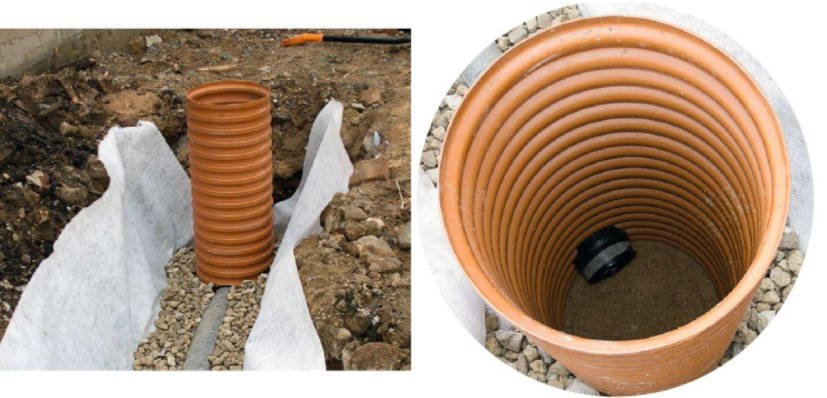
Deep drainage is arranged at an early stage of development of the site and in any case before the beginning of landscape works
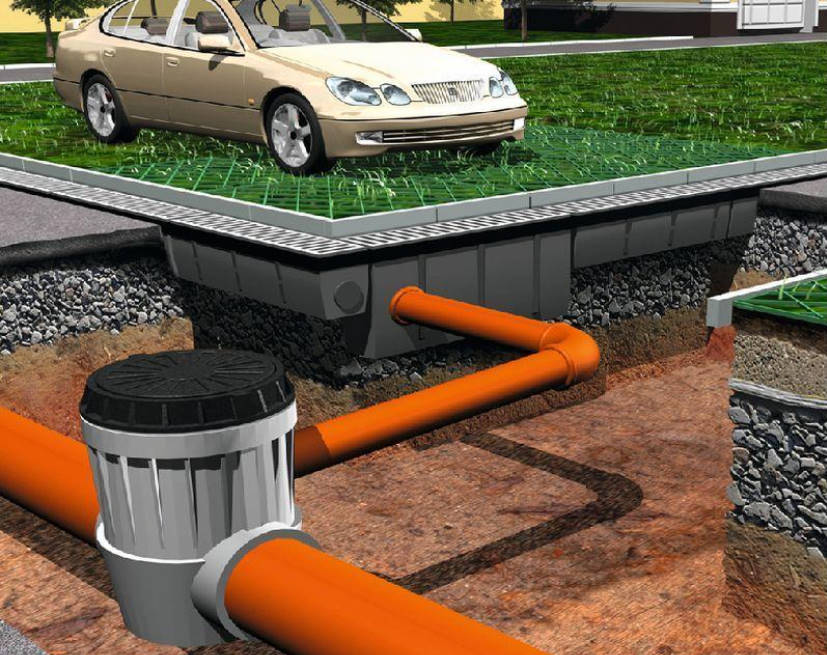
The drainage system should be installed in conjunction with the construction of drained areas
